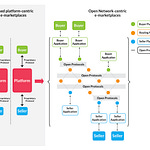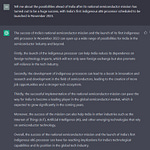Matsyanyaaya #1: Material Partnerships Today and Tomorrow
— Pranav R Satyanath
In June 1939, the United States Congress passed the Strategic and Critical Materials Stockpiling Act to ensure the steady supply of raw materials that were deemed to be critical for economic development and national security. Strategic materials at the time included those that were essential for nuclear research, like uranium and thorium. Although these materials were by no means rare in the form of natural ore, the rarity of these materials came in two forms. 1.) They were concentrated in a small number of locations around the world. 2) The process of refining the ore to useful purity was long and expensive.
Of course, since nuclear energy could be harnessed for both the purposes of economic development and making nuclear weapons, securing these materials for one's own interests while stopping the adversary from doing the same became the top priority. Like-minded nations, therefore, had a keen interest in keeping their knowledge of strategic materials a secret, leading to agreements in the early years such as the Quebec Agreement of 1943, under which the US, Britain and Canada agreed to stockpile strategic materials and censor information regarding nuclear research.
In the early years of the Cold War, the Americans went many steps further to ensure that the Atlantic alliance provided a steady supply of strategic materials. First, through the Marshall Plan’s controlling body, the Economic Cooperation Administration, the US incentivised their European partners to produce strategic materials which were later exported to the US. Second, the US and the NATO members established the Coordinating Committee for Multilateral Export Controls (COCOM) to exercise control over the East-West trade on strategic materials. The goal was to restrict the export of material that were in short-supply, rather than use it as a tool for coercion. This is because it was assumed that the Eastern bloc was self-sufficient in most strategic materials.
Alliances and partnerships in the early days of the Cold War played an important role in securing materials that were deemed as essential for national security. But why is this history relevant today? Last month, the United States announced the establishment of the Mineral Security Partnership (MSP), whose goal is to secure critical materials that are deemed essential for economic development. The new partnership includes Australia, Canada, Finland, France, Germany, Japan, the Republic of Korea, Sweden, the European Commission, the UK, the US, and the US.
Today’s strategic materials (or critical materials) are quite different from the days of the Cold War. Lithium, cobalt, samarium, europium, and neodymium make up a bulk of the elements that are crucial for the production of batteries and electronic components. China has a clear dominance in the supply of rare earths, with nearly 90% of the global supply concentrated in the Bayan Obo region of Inner Mongolia. China’s dominance over rare earth elements has remained a concern for many years, with its monopoly over strategic materials increasing due to the growing demand for green technologies. Other concerns include the exploitative nature of Chinese mining in Africa, particularly the Democratic Republic of Congo.
The success of the MSP will be determined by how effectively the partnering countries can secure the supply of strategic materials and decouple from Chinese dependence. This not only means that the countries within the partnership bring together their own resources, but also successfully negotiate fair agreements with other countries, particularly resource-rich African states.
India currently lacks a coherent strategy for securing strategic materials. Since the security of these materials is highly contingent on India’s ability to partner with resource-rich countries, India must make every effort to join partnerships such as the MSP. Domestically, India must set up a Department of Rare Earths to spearhead India’s rare earth diplomacy and attract investment from foreign players
.
Cyberpolitik: Does China See Everything?
— Ranjeet Rane
"Everything is seen in China." These were the famous (last?) words of a member of TikTok’s Trust and Safety team as per a report by Buzzfeed last month. Tik Tok - the viral video-sharing app owned by Chinese tech company ByteDance - is no stranger to regulatory staredowns in the US. In 2020, President Donald Trump issued an executive order requiring TikTok to be sold to an American company or risk getting banned. TikTok contested the order in court, and later, President Biden revoked it. As it turns out, the reasons the Trump administration gave for issuing the order, namely the rampant collection of user data, including biometric data and its access by Chinese authorities, may not have been entirely incorrect.
The Buzzfeed report that analysed recordings from internal team meetings points to unhindered access to US data in China despite assurances given otherwise. The chain of events set off by the report included TikTok’s response to a letter by US senators where it acknowledged that certain employees outside the US could access information from American users. The Senate Intelligence Committee has now issued a letter to the Federal Trade Commission asking it to open an investigation into TikTok’s repeated misrepresentations about its data security practices and corporate governance in front of US lawmakers. This was followed by a Federal Communications Commission (FCC) member writing to Apple and Google to ban the app from their respective app stores, citing national security concerns.
Their concerns are not entirely unfounded. TikTok’s data harvesting and sharing models have come under continued scrutiny across the globe, primarily owing to the possible influence of the Chinese Communist Party (CCP) over the leadership of ByteDance. This was particularly laid bare in 2018, when Zhang Yiming, ByteDance’s founder, made a public apology and shut down ByteDance’s joke-sharing app for having “content that goes against socialist core values”.
Interestingly, the executive order issued by President Trump came on the back of a blanket ban issued by India in July 2020 against a slew of Chinese apps, including TikTok, as a reaction to a bloody border skirmish. The explanation given in a widely circulated press release mentioned that these apps are engaged in “stealing and surreptitiously transmitting users’ data in an unauthorized manner to servers which have locations outside India”. National security concerns were being addressed through technology policy interventions for the first time - a template the US administration may now employ for its own interests.
TikTok has responded with Project Texas - an attempt to keep all American user data on the Oracle server so that the data always stays within the US. But looking at the damage already done, this may be too little and too late.
Matsyanyaaya #2: How India and China can Develop a Geoengineering Governance Framework
— Arjun Gargeyas
In this week’s edition, I am going a little off-topic and discussing environmental policy and climate tech for combating climate change. Here is where the concept of geoengineering comes into the picture.
What and why it matters
In layman’s terms, geoengineering refers to the human involvement made in the Earth’s natural processes to counteract the effects of climate change. It involves large-scale interventions in the planet’s functioning by human actions in order to mitigate the extent of the crisis. The main principle used in the process is reducing the CO₂ content in the atmosphere through human intervention. This would result in trapping less heat in the atmosphere eventually slowing down the effect of global warming. It is considered both as an alternative to cutting carbon emissions and as a field of ‘scientific taboo’ due to its research infancy and any probable implications on the environment itself.
The main field of geoengineering is the concept of solar radiation management, which involves reflecting a fraction of the incoming sunlight to cool a warming planet. One process is ‘stratospheric injection,’ which involves spraying reflective aerosols into the stratosphere. Attempts have also been made by Russian scientists in what they have called the SPICE Project. The scientists ended up pumping particles through a high-altitude balloon that would scatter them once reaching a specific height in the atmosphere.
However, these experiments were frowned upon by the majority of the scientific community. Fears were raised regarding how tinkering with natural processes might alter precipitation patterns and reduce crop growth in certain areas. Further damage to the ozone layer was also considered a possibility. This kind of blow-back risked unintended consequences for humanity as a whole. With no framework to govern the use of solar engineering methods, there is a need for someone to step in and ensure responsible development of the field.
Development vs deployment?
India and China currently have their task cut out while framing climate-related policies. This is due to the high population and the enormous volume of carbon emissions by both countries. Geoengineering and solar radiation management is a well-thought-out approach to building cost-effective models to tackle the effects of climate change. Natural phenomena and their subsequent aftereffects have buttressed the idea of this concept.
However, there have been recent calls to completely stop any solar radiation management research. The ‘International Solar Geo Non-Use Agreement’ was proposed by over 60 scholars (mostly from the West) arguing for a moratorium on research in the field. They claimed that the concept was still theoretical and that reflecting large amounts of sunlight can damage existing ecosystems and human settlements. While this might be true, it may not justify halting primary research in the field.
India and China have the possibility of driving forward the conversation on continuing credible research in the field of geoengineering. Both countries have been torchbearers for the rest of the developing world at climate conferences and both can work together to formulate a well-rounded governance framework regulating the research and technology in the field. If this is indeed a fast-track solution to tackle climate change, developing countries can indulge in utilising these techniques to meet climate goals.
While ethical considerations should be taken into account, the two countries can develop a holistic model (that also looks at potential negative consequences of geoengineering techniques) to have solar radiation management as a probable climate policy option. National agencies can be set up for funding solar geo-tech research and also keep tabs on the experiments being conducted. Incentivising development in the field must be a priority for both countries.
However, considering the historical criticism of the field as well as the concept of unanticipated consequences of human actions, the framework must be robust enough to account for the pitfalls of the field itself. Advocating for responsible use of these techniques must be a priority for both nation-states. They must ensure that any governing mechanism that deals with geoengineering processes and techniques must address the risks that might result from human intervention. There must also be a mechanism to deploy these technologies when considerable research has been conducted and the potential effects of using these geoengineering techniques have been identified. It is in the interest of both India and China to advocate for an enhanced research environment in the geoengineering field. This can change the way states approach tackling climate change and meeting their climate goals.
(This is an edited version of an article that came out first in Firstpost)
Antariksh Matters: Russia’s Satellite Dazzler
— Aditya Ramanathan
Fresh open-source intelligence suggests Russia is developing a fixed laser-based satellite dazzling system. In a new article in The Space Review, Bart Hendrickx, a veteran observer of Russia’s space programme, presents evidence that Russia is building a satellite dazzling system called Kalina at the Ministry of Defence-run Krona space surveillance facility in the Caucasus.
According to Hendrickx, construction began on the Kalina project in August 2019. The latest satellite imagery shows a telescope dome is already in place. Hendrickx cites tender documents that suggest Kalina will feature a dome that can separate into two sections in less than 10 minutes and enable “the telescope to scan the entire sky all the way from the zenith to an elevation of 30°”.
Kalina appears to be designed to both transmit lasers and receive them when a target reflects them back, which allows for more accurate tracking. It also features an “adaptive optics system,” which is almost certainly the designed for its specific counterspace role:
“Kalina most likely needs the adaptive optics system to produce images of the target that are sharp and detailed enough to make sure that the laser beams can subsequently be accurately aimed at the object’s optical systems.”
Other Dazzlers Russia claims to already have at least one satellite-dazzling system in operation: the Peresvet mobile laser dazzler. First unveiled in 2018, the Peresvet was reportedly operational by December 2019. According to the Secure World Foundation’s latest Global Counterspace Capabilities report, the Peresvet “consists of a laser connected to a gimbaled mirror, all of which is mounted inside a truck-towed trailer.”
The Peresvet is deployed with Russia’s strategic forces and is evidently meant to dazzle or disable both low earth orbit (LEO) satellites and aerial reconnaissance vehicles tracking batteries of mobile ICBM launchers such as the RS-24/ Topol-MR. Hendrickx points out that it’s not clear is whether Peresvet and Kalina are meant to merely “dazzle”, that is, temporarily make the lenses on a target satellite non-operational, or whether they could “blind” a satellite, that is, permanently damage or destroy optics.
What’s also left to speculation is whether these systems are actually effective: accurately aiming a laser at a satellite, keeping it on target for a sufficient period of time, and overcoming atmospheric attenuation, are all difficult tasks. Furthermore, many satellite lenses can automatically shut off when they are struck by blinding light. This may make it difficult to cause actual damage, but by forcing an adversary satellite to briefly shut its lenses, an attacker like Russia may still achieve its objectives.
Indeed, one of the key attractions of such lasers is that they can be used in a variety of strategic conditions, ranging from peacetime and crises (in which they may only “dazzle”), all the way up to outright war, (in which they could seek to cause permanent damage to target satellites). Unsurprisingly, China appears to have an anti-satellite laser system deployed in Xinjiang, and reportedly “illuminated” a US satellite in 2006. In the coming years, it’s quite likely leading powers will field such systems on highly mobile land, naval, and airborne platforms.










